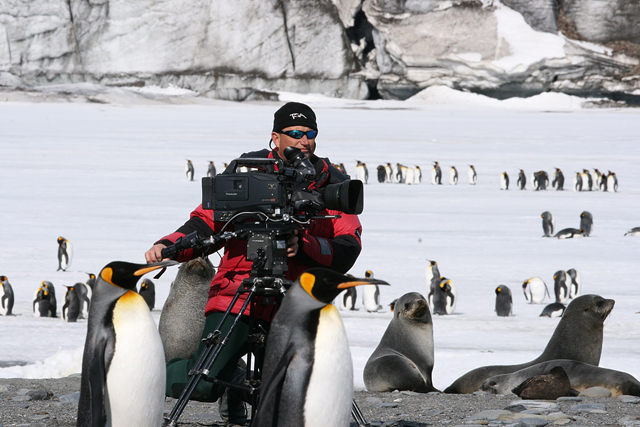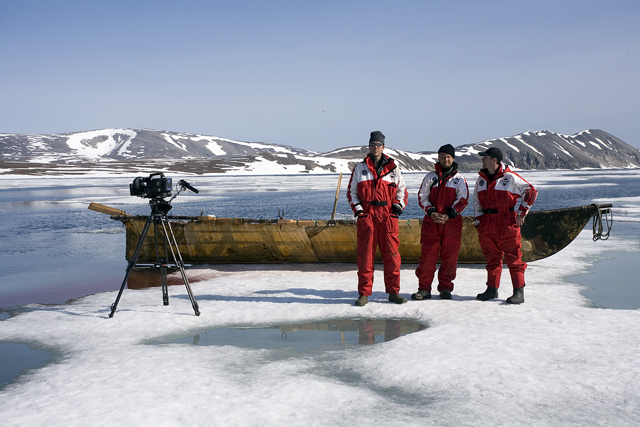Frozen PlanetNew BBC/Discovery documentary turns its focus to polar regionsPosted September 25, 2009
How do you top what many have called the most popular natural history television program in history? Set the sequel at the literal ends of the Earth — the Antarctic and Arctic. BBC The BBC natural history “The feeling was the polar regions are landscapes so vast and relatively unexplored and uninhabited that these new technologies that we had [used on “Planet Earth”] lent themselves to showcasing the polar regions like never before,” Hunter said. That technology included a camera system called the Cineflex, which fits a HD camera with a telephoto lens inside a gyro-stabilized bubble. Attached to a helicopter, the camera system allowed filmmakers to get tight, close-up shots of wildlife from hundreds of meters away in the air, including an epic hunt by African wild dogs for “Planet Earth.” Antarctica has been the subject of numerous film projects in the last few years. Most recently, Hollywood director Werner Herzog turned his unique looking glass on the continent in the Oscar-nominated documentary, “Encounters at the End of the World,” another project supported by the NSF. And, of course, “March of the Penguins,” about the triumphs and travails of an emperor penguin colony, became one of the highest-grossing documentaries of all time. Hunter said the BBC-Discovery project hopes to create the “ultimate portrait” of the polar regions. The 17-member film crew heading to Antarctica next month actually consists of several teams, which will dive under the sea ice, buzz around the mouth of an active volcano in a helicopter and spend an entire season with an Adélie penguin colony at Cape Crozier. “It’s a lot of people coming and going. A lot of stories we’re trying to cover,” said Hunter, himself a PhD who studied primates in Ethiopia. The large team has offered some challenges to the people charged with equipping and moving the filmmakers to various field camps and locations, including South Pole Station “It is complicated and it is all over the place just because it is a lot of people,” said Rob Edwards, Science Planning Support manager for Raytheon Polar Services The first filmmakers will arrive shortly after the summer field season begins on Sept. 29. The diving team wants to get in the water as soon as possible to take advantage of the excellent visibility during that time of the year, Hunter said. “The one thing we’re really trying to capture is that alien world under the ice,” he added. “Above the ice, the conditions are horrific and it feels like a desolate wasteland, but once you get under the sea ice, there’s this whole rich and colorful world of life going on down there.” Divers will also film emperor penguins at the Cape Washington colony along the Victoria Land coast using super slow-motion cameras that can record 1,000 frames per second, according to Hunter. “I think with the penguins rocketing around, the bubble streams come off them like comet trails; putting this high-speed camera underwater will be a completely new look — a very stylized sequence, quite balletic,” he said. Most of the episodes in the seven-part “Frozen Planet” series will feature the stunning wildlife cinematography that marked “Planet Earth,” but will also focus on people and conservation in the final two episodes, a departure from the previous project. Hunter said filming in the Antarctic and Arctic, in some ways, has been harder than the globetrotting of “Planet Earth” given the distances and extremes in climate. “I don’t think any of us have worked as hard logistically,” he said. “Sometimes just to get a film crew to one of the locations that you want to be in requires so much support and infrastructure and money, really, that it’s out of the scope of many documentary budgets.” Among the field team will be Sir David Attenborough Edwards said Attenborough, like all the documentary crew, would be a part of the McMurdo community like any other science or media event. That means living in dorm buildings while at the research station and eating in a communal dining hall. Still, he said he expects there to be some buzz around the film team even by a group of people who hobnob with artists and filmmakers nearly every year. “We’re used to pretty exciting stuff every year,” Edwards said. “However, at least for some people, the idea of working with the BBC — these guys are the top pros in the natural history business — I’m sure some people are very excited to meet [them].” NSF-funded research in this project: Carlos Gutierrez, Discovery Communications, Inc., Award No. 0848627 |



For USAP Participants |
For The Public |
For Researchers and EducatorsContact UsNational Science FoundationOffice of Polar Programs Geosciences Directorate 2415 Eisenhower Avenue, Suite W7100 Alexandria, VA 22314 Sign up for the NSF Office of Polar Programs newsletter and events. Feedback Form |





